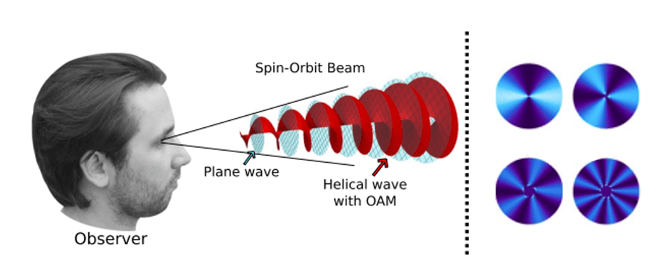Eye diseases such as macular degeneration can have a devastating impact on quality of life. Early detection and treatment are thus crucial for preventing irreversible vision loss. A previous study found that the human eye can detect differences in ‘structured’ light beams. Such light beams are composed of a coherent superposition of differently polarized planar and helical waves. This structured light can be created by coupling polarization and orbital angular momentum to form spin-orbit states with space-varying polarization profiles. The original study determined that a healthy human eye can discriminate between two different spin-orbit states by observing distinct images (i.e., the number of azimuthal fringes) induced by viewing each state. These findings will be expanded to further explore the limits of human perception of structured light. A strong association between an individual’s perception of a structured light beam and the imaging data collected from their eye with the same beam is expected. The possibility of using structured light beams to image ocular structures, including the macular pigment, the cornea, and the retina, will be investigated. Ocular imaging using structured light beams has the potential to detect subtle changes in macular pigment and other ocular structures that occur before macular degeneration progresses to the point of vision loss. Such new sensing tools could enable the early detection and treatment of macular degeneration and reduce the significant societal burden of the disease.

Figure 1. (Left) Representation of a spin-orbit beam composed of a coherent superposition of planar and helical polarized states. (Right) The number of fringes that the eye sees when viewing the spin-orbit beams.
Related Content

Hybrid Quantum Materials towards Topological Quantum Computing
Summary Proximity engineered hybrid materials have shown promise for topological quantum information processing. This form of quantum computing provides a stable, error-tolerant approach for building scalable quantum information processors. Topological quantum computing relies on braiding non-Abelian particles, such as Majorana fermions, which do not exist in nature. One can however use materials engineering to […]
December 8, 2018

Quantum Simulations of Fundamental Interactions
Summary To address questions in modern physics such as “what is the structure of matter inside neutron stars?” we need better computational methods to evaluate the interplay of fundamental forces between elementary particles. To-date the response to such questions rests on numerical computer simulations that are inherently limited. In this project, we develop new theoretical […]
April 18, 2019

Micro-Supercapacitors Based on Termination Optimized MXene Quantum Dots with Ultra-High Rate Capability and Fast Frequency Response
Micro-supercapacitors (MCs) are miniaturized energy storage devices that can enhance the performance of wearable health devices, medical implants, wireless sensors, and micro-electromechanical systems due to their fast frequency response, long life cycle, and vast temperature operation. However, to make these MC systems into commercially feasible products, necessary improvements to current MC performance are necessary, primarily […]
June 12, 2023

Entangled States of Beams and their Applications
Summary With David Cory and collaborators at the National Institute of Standards and Technology (NIST) we explore how to engineer beams of neutron or photons that carry entanglement. The degrees of freedom that can be entangled include spin (polarization), momentum, displacement, and angular momentum. These have potential applications ranging from studies of helical internal magnetic fields […]
September 7, 2016

